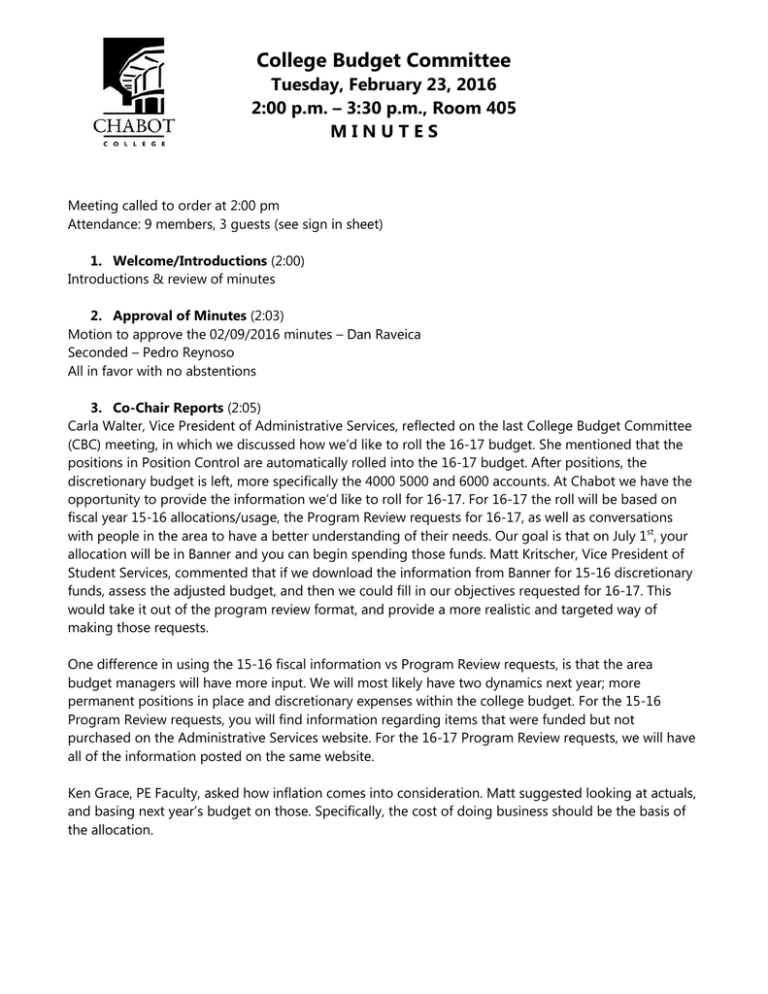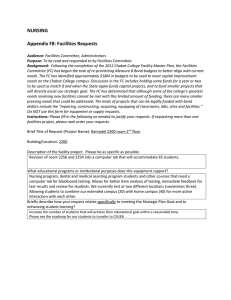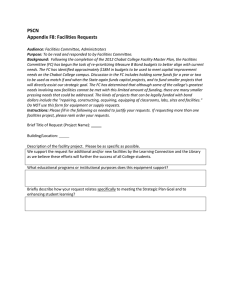College Budget Committee Tuesday, February 23, 2016
advertisement

College Budget Committee Tuesday, February 23, 2016 2:00 p.m. – 3:30 p.m., Room 405 MINUTES Meeting called to order at 2:00 pm Attendance: 9 members, 3 guests (see sign in sheet) 1. Welcome/Introductions (2:00) Introductions & review of minutes 2. Approval of Minutes (2:03) Motion to approve the 02/09/2016 minutes – Dan Raveica Seconded – Pedro Reynoso All in favor with no abstentions 3. Co-Chair Reports (2:05) Carla Walter, Vice President of Administrative Services, reflected on the last College Budget Committee (CBC) meeting, in which we discussed how we’d like to roll the 16-17 budget. She mentioned that the positions in Position Control are automatically rolled into the 16-17 budget. After positions, the discretionary budget is left, more specifically the 4000 5000 and 6000 accounts. At Chabot we have the opportunity to provide the information we’d like to roll for 16-17. For 16-17 the roll will be based on fiscal year 15-16 allocations/usage, the Program Review requests for 16-17, as well as conversations with people in the area to have a better understanding of their needs. Our goal is that on July 1st, your allocation will be in Banner and you can begin spending those funds. Matt Kritscher, Vice President of Student Services, commented that if we download the information from Banner for 15-16 discretionary funds, assess the adjusted budget, and then we could fill in our objectives requested for 16-17. This would take it out of the program review format, and provide a more realistic and targeted way of making those requests. One difference in using the 15-16 fiscal information vs Program Review requests, is that the area budget managers will have more input. We will most likely have two dynamics next year; more permanent positions in place and discretionary expenses within the college budget. For the 15-16 Program Review requests, you will find information regarding items that were funded but not purchased on the Administrative Services website. For the 16-17 Program Review requests, we will have all of the information posted on the same website. Ken Grace, PE Faculty, asked how inflation comes into consideration. Matt suggested looking at actuals, and basing next year’s budget on those. Specifically, the cost of doing business should be the basis of the allocation. 4. Action/Discussion Items a. Facilities Committee Report (2:20 – 2:45) – Matt Kritscher, Vice President of Student Services Matt provided one handout (see website, “Handout – Facilities”) The handout shows the Facilities & Sustainability Committee’s draft list of small projects on campus, funded through Measure B (Bond). The Measure B (Bond) funds allocated for instructional equipment through the Budget Committee are a separate pot of funds. Matt proposed a scenario in which we spend the rest of the Measure B (Bond) to get what we need done in small projects. We could begin three or so of these projects within this fiscal year, and possibly conclude them within 18 months. As of this morning, the College President said the initial proposal reports for a new Bond are very positive. So positive that they may put it on the June ballot rather than November. Jeff Drouin, Athletic Director, asked if we go for a new Bond in June how will the possible new Bond play into the current small project list. Carla commented that one option would be to keep a running list of everything you need so you are continuously knocking things off while still reassessing. If building 1600 is still on the list, and we get a new Bond, we should reassess that request because now there are new funds available. Noell Adams, Classified Senate President, asked if the small project list was in any order of priority. Matt reported that Facilities & Sustainability Committee is trying to wrap up unfinished business, in order to address all of the projects equally, based on their need. Noell asked about the decision process for the proposal to use FY 16-17 Deferred Maintenance/Instructional Equipment funds for some of the small projects. Matt noted that if approved it would then to go College Council. If approved at College Council, the proposal would then move forward. b. College Budget Committee Evaluation Tool (2:45 – 3:15) Carla asked what the college process is, to allocate funds across campus. For example, if we were to receive 1mil from the state in one time funds that are non-restricted, how do we allocate those funds? Chasity Whiteside, Executive Assistant, asked if we have a current list of campus needs. Bob Buell, Fire Technology Faculty, expressed the need for a college reserve, in case a need arises that cannot be funded. This Budget Committee will begin discussing a campus allocation model, as we move forward. In May we said we’d like to see how we did this semester. The committee started drafting an allocation framework as follows: Page 2 of 4 This will be discussed at the next few meetings. 5. For the Good of the Order (3:00) In preparing for a visit from the vice chancellor of business services, the committee determined they would like to know more about: major budget assumptions Who is responsible for funding faculty and staff negotiated raises budget development process at district, benefits of a budget allocation model, definition of which funds carry over, stability, the cost of doing business, and the faculty obligation number (FON) and how it effects the budget. 6. Adjournment Meeting adjourned at 3:35 pm Handouts and/or Links Provided: Handout – Facilities Upcoming Meeting Dates: March 8, March 22, April 12, April 26, May 10 **The meeting minutes were graciously prepared by Chasity Whiteside** Page 3 of 4 Chabot College Mission Chabot College is a public comprehensive community college that prepares students to succeed in their education, progress in the workplace, and engage in the civic and cultural life of the community. Our students contribute to the intellectual, cultural, physical, and economic vitality of the region. The college responds to the educational and workforce development needs of our regional population and economy. As a leader in higher education, we promote excellence and equity in our academic and student support services. We are dedicated to student learning inside and outside the classroom to support students’ achievement of their educational goals. Page 4 of 4

